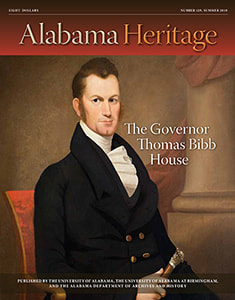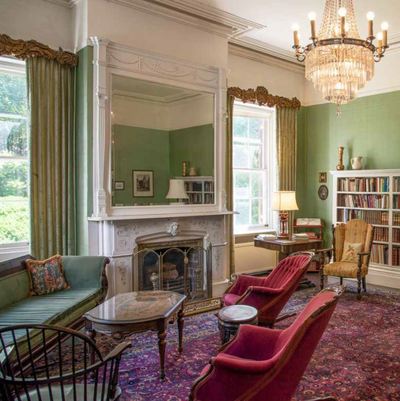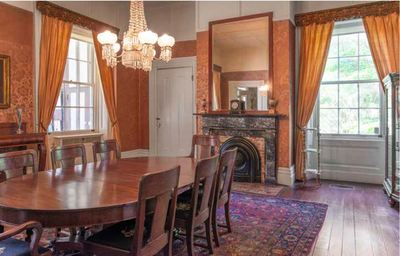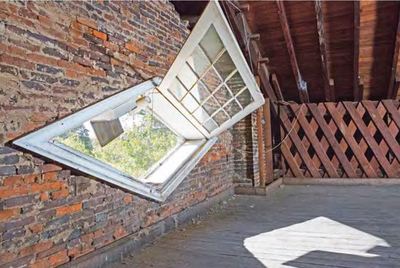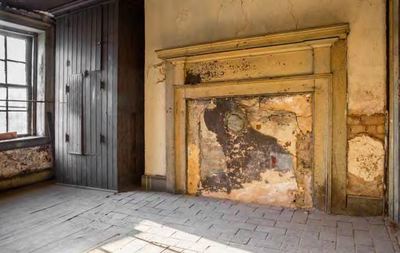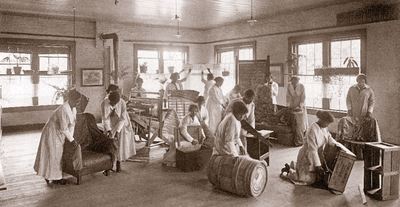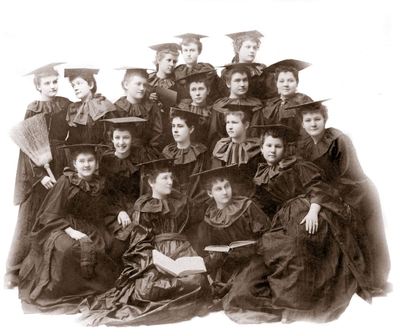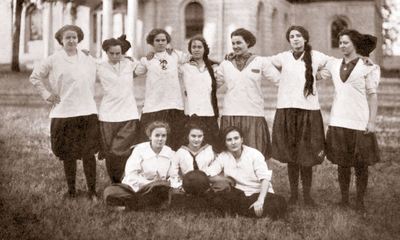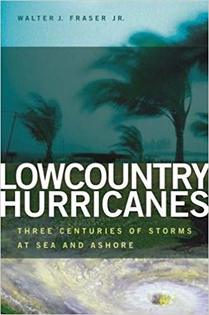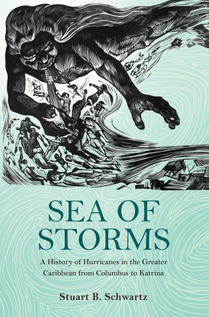|
On the cover: Gov. Thomas Bibb.
(Alabama Department of Archives and History) |
FEATURE ABSTRACTS
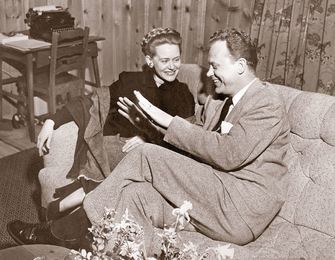 Joe David Brown with his second wife, Fran, in a 1949 photograph taken in St. Michaels on the Eastern Shore of Maryland, possibly a publicity shot to promote the upcoming release of the movie based on his novel Stars in My Crown. His typewriter and writing table can be seen in the background. (Stuart A. Rose Manuscript, Archives, and Rare Book Library, Emory University)
Joe David Brown with his second wife, Fran, in a 1949 photograph taken in St. Michaels on the Eastern Shore of Maryland, possibly a publicity shot to promote the upcoming release of the movie based on his novel Stars in My Crown. His typewriter and writing table can be seen in the background. (Stuart A. Rose Manuscript, Archives, and Rare Book Library, Emory University)
Stars in His Crown
The Writing Life and Afterlife of Joe David Brown
by Bert Hitchcock
Though his name is little known today, many people probably recognize the work of author and Birmingham native Joe David Brown. Brown left Birmingham as a young man, serving in the military and working a number of different writing-related jobs, including as a newspaper reporter at several Alabama publications. After The Saturday Evening Post published some of his writing, he embarked on a career as a novelist, producing many books while periodically holding more permanent employment as a correspondent. Brown worked throughout the world before returning to the south, settling in Georgia near the end of his life. Though his popularity waxed and waned throughout the years, his work is immortalized in the pages of his many books and in cinematic reproductions of those works, including one that earned a young Tatum O’Neal an Academy Award.
About the Author
Bert Hitchcock is Hargis Professor Emeritus of American Literature, Auburn University. A graduate of Demopolis (Alabama) High School, he attended Auburn University (BA), the University of Oregon (MA), the University of Melbourne, Australia (as a Rotary Foundation Fellow), and Duke University (PhD). He is the author of a number of scholarly publications on southern literature and co-editor of four editions of the textbook anthology American Short Stories (Pearson, 2007). For more on Hitchcock, see Amazon.
For Additional Information
For additional information on Joe David Brown, please see the following sites.
The Writing Life and Afterlife of Joe David Brown
by Bert Hitchcock
Though his name is little known today, many people probably recognize the work of author and Birmingham native Joe David Brown. Brown left Birmingham as a young man, serving in the military and working a number of different writing-related jobs, including as a newspaper reporter at several Alabama publications. After The Saturday Evening Post published some of his writing, he embarked on a career as a novelist, producing many books while periodically holding more permanent employment as a correspondent. Brown worked throughout the world before returning to the south, settling in Georgia near the end of his life. Though his popularity waxed and waned throughout the years, his work is immortalized in the pages of his many books and in cinematic reproductions of those works, including one that earned a young Tatum O’Neal an Academy Award.
About the Author
Bert Hitchcock is Hargis Professor Emeritus of American Literature, Auburn University. A graduate of Demopolis (Alabama) High School, he attended Auburn University (BA), the University of Oregon (MA), the University of Melbourne, Australia (as a Rotary Foundation Fellow), and Duke University (PhD). He is the author of a number of scholarly publications on southern literature and co-editor of four editions of the textbook anthology American Short Stories (Pearson, 2007). For more on Hitchcock, see Amazon.
For Additional Information
For additional information on Joe David Brown, please see the following sites.
A House for the Ages
by Donna Castellano
by Donna Castellano
Though Thomas Bibb owned several homes in Alabama, perhaps the most renowned is his nineteenth-century Huntsville dwelling, one of the state’s earliest examples of Greek Revival architecture. Bibb built the house on the site of his former home, which he purchased after his time as the state’s governor. After his death, the property passed in and out of his descendants’ hands, finally returning to the family in the 1920s. The home, which has been included in the Historic American Building Survey, has been preserved largely as it was in Bibb’s time, offering visitors a rare glimpse into the life of one of Alabama’s most prominent nineteenth-century citizens.
About the Author
Donna Castellano is the executive director of the Historic Huntsville Foundation, a nonprofit historic preservation organization dedicated to the preservation of Huntsville-Madison County’s historic resources through education, advocacy, and direct funding. Castellano has a MA in history from the University of Alabama-Huntsville with a specialization in the American South. She has spent the better portion of her adult life dedicated to the preservation of Huntsville-Madison County’s historic buildings, neighborhoods, and downtowns.
The Historic Huntsville Foundation, a nonprofit historic preservation organization, is indebted to Jose Betancourt, associate professor of art and art history at the University of Alabama-Huntsville, for partnering with us to document and photograph the Bibb House before the house leaves family hands. We are also grateful to the heirs of Dr. Eleanor Newman Hutchens.
For Additional Information
For more information on Thomas Bibb, please see http://www.encyclopediaofalabama.org/article/h-1531.
For more information on William Wyatt Bibb, please see http://www.encyclopediaofalabama.org/article/h-1416.
For more information about the Historic Huntsville Foundation, please see
http://www.historichuntsville.org/.
About the Author
Donna Castellano is the executive director of the Historic Huntsville Foundation, a nonprofit historic preservation organization dedicated to the preservation of Huntsville-Madison County’s historic resources through education, advocacy, and direct funding. Castellano has a MA in history from the University of Alabama-Huntsville with a specialization in the American South. She has spent the better portion of her adult life dedicated to the preservation of Huntsville-Madison County’s historic buildings, neighborhoods, and downtowns.
The Historic Huntsville Foundation, a nonprofit historic preservation organization, is indebted to Jose Betancourt, associate professor of art and art history at the University of Alabama-Huntsville, for partnering with us to document and photograph the Bibb House before the house leaves family hands. We are also grateful to the heirs of Dr. Eleanor Newman Hutchens.
For Additional Information
For more information on Thomas Bibb, please see http://www.encyclopediaofalabama.org/article/h-1531.
For more information on William Wyatt Bibb, please see http://www.encyclopediaofalabama.org/article/h-1416.
For more information about the Historic Huntsville Foundation, please see
http://www.historichuntsville.org/.
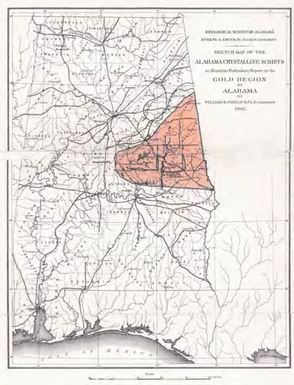 Sketch Map of the Alabama Crystalline Schists to illustrate the Preliminary Report on the Gold Region of Alabama by geologist William B. Phillips was published in 1892. Hog Mountain can be seen located in the center of the highlighted region. (Alabama Department of Archives and History)
Sketch Map of the Alabama Crystalline Schists to illustrate the Preliminary Report on the Gold Region of Alabama by geologist William B. Phillips was published in 1892. Hog Mountain can be seen located in the center of the highlighted region. (Alabama Department of Archives and History)
Alabama Gold
by Peggy Jackson Walls
Before the Gold Rush swept America’s West Coast, prospectors flocked to the southeast in search of fortune. Gold was discovered in Alabama as early as the 1830s, and for a time several mines dominated Alabama’s gold industry. Often all the men from a family worked in the mines, and though accidents did occur, the miners typically found the life rewarding. However, Alabama’s mines closed after about one hundred years, leaving employees to pursue other careers. Still, the impact of the gold rush in Alabama remains clear throughout areas such as Tallapoosa County, where once dreams rode on the earth’s riches.
About the Author
Peggy Jackson Walls holds a BS from AUM College and an MA from Auburn University. She taught for 23 years in the Alabama Public School system and for another 15 as an online instructor for the University of Phoenix. A native of Tallapoosa County, Walls published articles about local history, including interviews with local people, including miners who worked at Hog Mountain gold mine in the 1930s. Expanding her research into other areas within the Alabama Gold Belt, Walls collected the mining stories into the book Alabama Gold, a History of the South’s Last Mother Lode, (History Press, 2016). She is co-author of Alexander City (Arcadia, 2011). Her research and poetry have been published in diverse publications, such as The Alabama Review (1984), and Chinaberries and Magnolia Blossoms (2012).
For Additional Information
For more on the gold industry in Alabama, see http://www.encyclopediaofalabama.org/article/h-1666.
Peggy Jackson Walls’s book is available at
https://www.amazon.com/Alabama-Gold-History-Souths-Mother/dp/1467135984
by Peggy Jackson Walls
Before the Gold Rush swept America’s West Coast, prospectors flocked to the southeast in search of fortune. Gold was discovered in Alabama as early as the 1830s, and for a time several mines dominated Alabama’s gold industry. Often all the men from a family worked in the mines, and though accidents did occur, the miners typically found the life rewarding. However, Alabama’s mines closed after about one hundred years, leaving employees to pursue other careers. Still, the impact of the gold rush in Alabama remains clear throughout areas such as Tallapoosa County, where once dreams rode on the earth’s riches.
About the Author
Peggy Jackson Walls holds a BS from AUM College and an MA from Auburn University. She taught for 23 years in the Alabama Public School system and for another 15 as an online instructor for the University of Phoenix. A native of Tallapoosa County, Walls published articles about local history, including interviews with local people, including miners who worked at Hog Mountain gold mine in the 1930s. Expanding her research into other areas within the Alabama Gold Belt, Walls collected the mining stories into the book Alabama Gold, a History of the South’s Last Mother Lode, (History Press, 2016). She is co-author of Alexander City (Arcadia, 2011). Her research and poetry have been published in diverse publications, such as The Alabama Review (1984), and Chinaberries and Magnolia Blossoms (2012).
For Additional Information
For more on the gold industry in Alabama, see http://www.encyclopediaofalabama.org/article/h-1666.
Peggy Jackson Walls’s book is available at
https://www.amazon.com/Alabama-Gold-History-Souths-Mother/dp/1467135984
Alabama's Female Academies
by Sharony Green
by Sharony Green
Though education has not always been equal for males and females, it may surprise readers to learn that as early as the nineteenth century, many of Alabama’s young women received a significant education at the state’s female academies. Even during the Civil War, women from economically advantaged families pursued their education and broadened their horizons. After the war southern academies began opening to serve African Americans, who had previously sought education in the north. Though the schools largely died out in the twentieth century, some, such as Judson College, continue functioning as educational institutions today.
About the Author
Sharony Green teaches history at the University of Alabama and is the author of Remember Me to Miss Louisa: Hidden Black-White Intimacies in Antebellum America (Northern Illinois University Press, 2015) and the 2016 recipient of the Barbara “Penny” Kanner Prize for excellent use of archival research. The prize is awarded by the Western Association of Women Historians. A native of Miami, Florida, with roots in the Bahamas and the Deep South, she is presently exploring racial and spatial politics in Florida since Andrew Jackson’s encounters with the Seminoles in that state through the present day. Her courses at UA find her and her students using Tuscaloosa as a “lab” to learn more about our shared past. For more on Green, see
https://sharonygreen.com
For Additional Information
For additional information on Alabama’s Female Academies, see http://www.encyclopediaofalabama.org/article/h-2492.
About the Author
Sharony Green teaches history at the University of Alabama and is the author of Remember Me to Miss Louisa: Hidden Black-White Intimacies in Antebellum America (Northern Illinois University Press, 2015) and the 2016 recipient of the Barbara “Penny” Kanner Prize for excellent use of archival research. The prize is awarded by the Western Association of Women Historians. A native of Miami, Florida, with roots in the Bahamas and the Deep South, she is presently exploring racial and spatial politics in Florida since Andrew Jackson’s encounters with the Seminoles in that state through the present day. Her courses at UA find her and her students using Tuscaloosa as a “lab” to learn more about our shared past. For more on Green, see
https://sharonygreen.com
For Additional Information
For additional information on Alabama’s Female Academies, see http://www.encyclopediaofalabama.org/article/h-2492.
DEPARTMENT ABSTRACTS
 Soapy Jones, along with her husband and business partner Erik Hanson, sell their Left Hand soaps, oils, and balms in their shop and through other outlets. (Sarah Westmoreland)
Soapy Jones, along with her husband and business partner Erik Hanson, sell their Left Hand soaps, oils, and balms in their shop and through other outlets. (Sarah Westmoreland)
Alabama Makers
The Art of Handcrafted Soap
By Christina Ausley
Thanks to the efforts of one entrepreneurial Alabama couple, many people in the state are discovering the benefits of all-natural skin care. And the Left Hand Soap Company has even converted some of the most stalwart naysayers, who initially visited the store with others. This installment of “Alabama Makers” chronicles the history and growth of this company, just one more Alabama original.
About the Author
Christina Ausley is a writer from Louisville, Kentucky, completing degrees in journalism and psychology at the University of Alabama. Alfa Insurance, sponsor of the “Alabama Makers” department in Alabama Heritage, is a Montgomery-based company committed to providing its family of customers with all of its life, auto, home, farm, and business insurance needs.
For Additional Information
For additional information about the Left Hand Soap Company, please see the following sites.
lefthandsoapcompany.com/
https://www.facebook.com/lefthandsoapco/
The Art of Handcrafted Soap
By Christina Ausley
Thanks to the efforts of one entrepreneurial Alabama couple, many people in the state are discovering the benefits of all-natural skin care. And the Left Hand Soap Company has even converted some of the most stalwart naysayers, who initially visited the store with others. This installment of “Alabama Makers” chronicles the history and growth of this company, just one more Alabama original.
About the Author
Christina Ausley is a writer from Louisville, Kentucky, completing degrees in journalism and psychology at the University of Alabama. Alfa Insurance, sponsor of the “Alabama Makers” department in Alabama Heritage, is a Montgomery-based company committed to providing its family of customers with all of its life, auto, home, farm, and business insurance needs.
For Additional Information
For additional information about the Left Hand Soap Company, please see the following sites.
lefthandsoapcompany.com/
https://www.facebook.com/lefthandsoapco/

Alabama 200
Tuskegee University: History Abounds
By Jay Lamar
As part of Alabama’s bicentennial celebration, ALABAMA 200 is delighted to announce its first college partner, Tuskegee University. Tuskegee holds its own rich history, as evidenced in its recent Founders Day Convocation. Among the many items celebrated by Tuskegee are the “Singing Windows” of the university chapel, a reconstruction of the original 1890 windows, which were destroyed by fire in the mid-twentieth century.
About the Author
Jay Lamar is Executive Director of the Alabama Bicentennial Commission.
For Additional Information
For more information, please see the following sites.
Tuskegee University: History Abounds
By Jay Lamar
As part of Alabama’s bicentennial celebration, ALABAMA 200 is delighted to announce its first college partner, Tuskegee University. Tuskegee holds its own rich history, as evidenced in its recent Founders Day Convocation. Among the many items celebrated by Tuskegee are the “Singing Windows” of the university chapel, a reconstruction of the original 1890 windows, which were destroyed by fire in the mid-twentieth century.
About the Author
Jay Lamar is Executive Director of the Alabama Bicentennial Commission.
For Additional Information
For more information, please see the following sites.
 Ashville’s Looney House (1818) is a two-story dogtrot. (Robin McDonald)
Ashville’s Looney House (1818) is a two-story dogtrot. (Robin McDonald)
The Alabama Territory
Quarter by Quarter
By Mike Bunn
As the Alabama Territory developed, men throughout the area rushed to develop cities and form communities. Though some settlements did not last, others, such as Florence and Huntsville, remain today. Most towns lacked substantial structures but featured necessities, including homes, businesses, stores, and newspaper offices. However, many communities lacked church buildings, as itinerant preachers roamed the landscape and congregations met in borrowed structures. Still, some of Alabama’s new towns were moving toward the vibrant areas that would shape the territory’s—and eventually the state’s—history.
About the Author
Mike Bunn serves as director of Historic Blakeley State Park in Spanish Fort, Alabama. This department of Alabama Heritage magazine is sponsored by the Alabama Bicentennial Commission and the Alabama Tourism Department.
For Additional Information
To read previous installments of “The Alabama Territory,” please see
https://www.alabamaheritage.com/alabama-territory.
For more information on the Alabama Bicentennial, please consult http://www.alabama200.org/
Quarter by Quarter
By Mike Bunn
As the Alabama Territory developed, men throughout the area rushed to develop cities and form communities. Though some settlements did not last, others, such as Florence and Huntsville, remain today. Most towns lacked substantial structures but featured necessities, including homes, businesses, stores, and newspaper offices. However, many communities lacked church buildings, as itinerant preachers roamed the landscape and congregations met in borrowed structures. Still, some of Alabama’s new towns were moving toward the vibrant areas that would shape the territory’s—and eventually the state’s—history.
About the Author
Mike Bunn serves as director of Historic Blakeley State Park in Spanish Fort, Alabama. This department of Alabama Heritage magazine is sponsored by the Alabama Bicentennial Commission and the Alabama Tourism Department.
For Additional Information
To read previous installments of “The Alabama Territory,” please see
https://www.alabamaheritage.com/alabama-territory.
For more information on the Alabama Bicentennial, please consult http://www.alabama200.org/
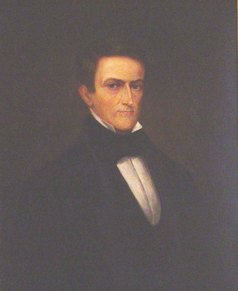 John Anthony Winston (1812–1871) was the fifteenth governor of Alabama. (Alabama Department of Archives and History)
John Anthony Winston (1812–1871) was the fifteenth governor of Alabama. (Alabama Department of Archives and History)
Alabama Governors
John Anthony Winston (1853-1857)
By Samuel L. Webb
As Alabama’s fifteenth governor, John Anthony Winston ascended to the office after a complicated history as both a politician and a man with a reckless temper. His victory, though, was strong; as a Jacksonian Democrat, he won by a landslide. However, the combination of poor health and his southern loyalties even after the Civil War led to the end of his political career.
About the Author
Samuel L. Webb holds a JD from the University of Alabama School of Law and a PhD in history from the University of Arkansas. This department is drawn from Alabama Governors: A Political History of the State, second edition, edited by Webb and Margaret E. Armbrester (University of Alabama Press, 2014).
For Additional Information
For more information about Winston, see http://www.encyclopediaofalabama.org/article/h-1621
John Anthony Winston (1853-1857)
By Samuel L. Webb
As Alabama’s fifteenth governor, John Anthony Winston ascended to the office after a complicated history as both a politician and a man with a reckless temper. His victory, though, was strong; as a Jacksonian Democrat, he won by a landslide. However, the combination of poor health and his southern loyalties even after the Civil War led to the end of his political career.
About the Author
Samuel L. Webb holds a JD from the University of Alabama School of Law and a PhD in history from the University of Arkansas. This department is drawn from Alabama Governors: A Political History of the State, second edition, edited by Webb and Margaret E. Armbrester (University of Alabama Press, 2014).
For Additional Information
For more information about Winston, see http://www.encyclopediaofalabama.org/article/h-1621
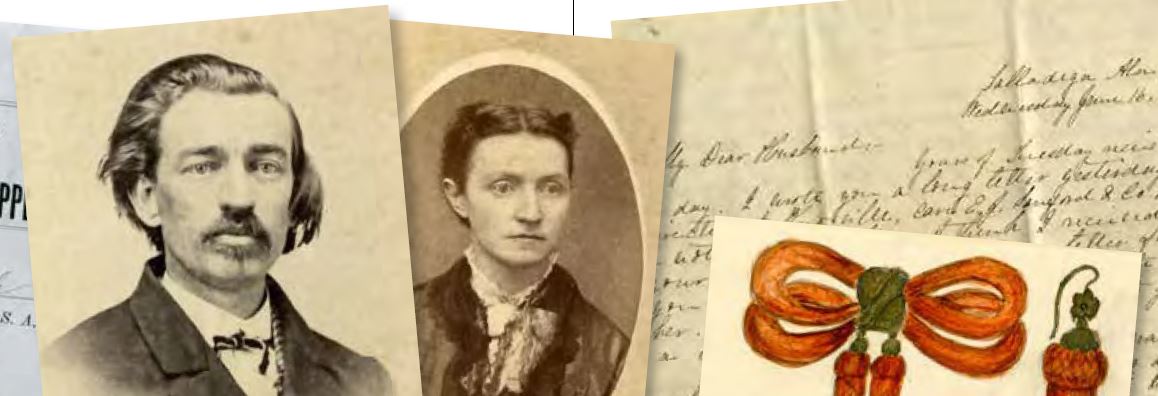
Alabama Treasures
The Toole Family Collection
By Tim L. Pennycuff
In addition to its many other archival treasures, the University of Alabama at Birmingham (UAB) now holds the collection of a significant Alabama medical family, the Barckley W. Toole family. Toole, who was born in 1835, served as a physician after fighting in the Civil War. He also likely sparked his family’s professional legacy, as four of his descendants followed him into the medical profession. Now UAB holds items from multiple generations of the Toole family, including letters, diaries, ledgers, photographs, medical instruments and apparatus, and textbooks.
About the Author
Tim L. Pennycuff holds a faculty appointment in the UAB Libraries and is the University Archivist at the University of Alabama at Birmingham.
For Additional Information
Additional information on the Toole archival collection and the contact information for the three units of Special Collections are available on the UAB Libraries website at http://library.uab.edu/special-collections.
The Toole Family Collection
By Tim L. Pennycuff
In addition to its many other archival treasures, the University of Alabama at Birmingham (UAB) now holds the collection of a significant Alabama medical family, the Barckley W. Toole family. Toole, who was born in 1835, served as a physician after fighting in the Civil War. He also likely sparked his family’s professional legacy, as four of his descendants followed him into the medical profession. Now UAB holds items from multiple generations of the Toole family, including letters, diaries, ledgers, photographs, medical instruments and apparatus, and textbooks.
About the Author
Tim L. Pennycuff holds a faculty appointment in the UAB Libraries and is the University Archivist at the University of Alabama at Birmingham.
For Additional Information
Additional information on the Toole archival collection and the contact information for the three units of Special Collections are available on the UAB Libraries website at http://library.uab.edu/special-collections.
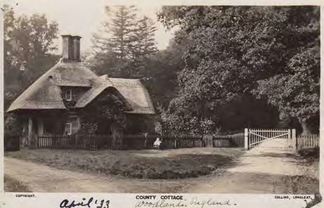 This Real Photo Post Card of County Cottage, in Woodlands, England, was found tucked away in the back of an old photo album and helped solve a long standing family mystery. (Mrs. Alan Lincoln Compton)
This Real Photo Post Card of County Cottage, in Woodlands, England, was found tucked away in the back of an old photo album and helped solve a long standing family mystery. (Mrs. Alan Lincoln Compton)
Behind the Image
A Picturesque Gatehouse Holds the Clue
By Frances Osborn Robb
Images hold all kinds of clues to the past, but for one couple, a postcard unlocked a wealth of family history. Alan and Mary Compton used a postcard from a family album (actually a specialized image called a Real Photo Post Card) to trace the origins of Alan’s family to its hometown in England—a place the Comptons had sought unsuccessfully for years.
About the Author
Frances Osborn Robb is the contributing editor for the “Behind the Image” department of Alabama Heritage magazine. She is the author of Shot in Alabama: A History of Photography, 1839–1941, and a List of Photographers (University of Alabama Press, 2017). She would like to thank Mary Compton for her assistance with this article.
For Additional Information
For more information, please see https://www.longleat.co.uk/longleat-house
A Picturesque Gatehouse Holds the Clue
By Frances Osborn Robb
Images hold all kinds of clues to the past, but for one couple, a postcard unlocked a wealth of family history. Alan and Mary Compton used a postcard from a family album (actually a specialized image called a Real Photo Post Card) to trace the origins of Alan’s family to its hometown in England—a place the Comptons had sought unsuccessfully for years.
About the Author
Frances Osborn Robb is the contributing editor for the “Behind the Image” department of Alabama Heritage magazine. She is the author of Shot in Alabama: A History of Photography, 1839–1941, and a List of Photographers (University of Alabama Press, 2017). She would like to thank Mary Compton for her assistance with this article.
For Additional Information
For more information, please see https://www.longleat.co.uk/longleat-house
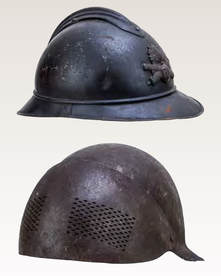 Top: French Model 1915 Adrian artillery helmet, on loan from Fort Morgan State Historic Site. Bottom: Belgian helmet, experimental model, 1917, on loan from Fort Morgan State Historic Site. (All photos Alabama Department of Archives and History)
Top: French Model 1915 Adrian artillery helmet, on loan from Fort Morgan State Historic Site. Bottom: Belgian helmet, experimental model, 1917, on loan from Fort Morgan State Historic Site. (All photos Alabama Department of Archives and History)
From the Archives
World War I Helmets
By Graham R. Neeley
As the World War I Centennial commemorations continue around the world, an exhibit at the Alabama Department of Archives and History showcases some of the equipment worn by soldiers in that conflict. Protective helmets for military personnel were new in the WWI era, and the ADAH collection highlights several types of headgear that emerged in this time, showing the evolution and variety of protective devices.
About the Author
Graham R. Neeley is the acting museum collections coordinator at the Alabama Department of Archives and History.
For Additional Information
For more information, please see http://archives.state.al.us
World War I Helmets
By Graham R. Neeley
As the World War I Centennial commemorations continue around the world, an exhibit at the Alabama Department of Archives and History showcases some of the equipment worn by soldiers in that conflict. Protective helmets for military personnel were new in the WWI era, and the ADAH collection highlights several types of headgear that emerged in this time, showing the evolution and variety of protective devices.
About the Author
Graham R. Neeley is the acting museum collections coordinator at the Alabama Department of Archives and History.
For Additional Information
For more information, please see http://archives.state.al.us
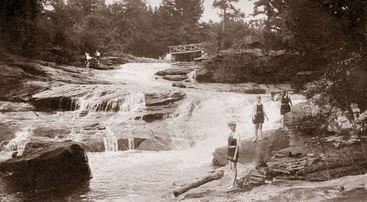 The newly constructed bridge over the falls during a girls’ camp in 1920. (Katherine Price Garmon)
The newly constructed bridge over the falls during a girls’ camp in 1920. (Katherine Price Garmon)
Portraits & Landscapes
100 Years of Laughing Waters: Winnataska's Centennial Celebration
By Rebecca Dewine Riddick
After its start as a prospective camp for Boy Scouts, a St. Clair County site became Camp Winnataska, where a century’s worth of Alabama’s young people have gathered to play, learn, and form lasting bonds. A former camper herself, Rebecca Riddick uses the centennial celebration to explore the camp’s rich history in shaping generations of youth across the state.
About the Author
Rebecca DeWine Riddick began her connection to Winnataska as a Chico camper, or “Little One,” in 1970 and continues today as a weekly camp director for the youngest campers.
For Additional Information
To learn more about Camp Winnataska, please see its website at https://www.winnataska.org/.
100 Years of Laughing Waters: Winnataska's Centennial Celebration
By Rebecca Dewine Riddick
After its start as a prospective camp for Boy Scouts, a St. Clair County site became Camp Winnataska, where a century’s worth of Alabama’s young people have gathered to play, learn, and form lasting bonds. A former camper herself, Rebecca Riddick uses the centennial celebration to explore the camp’s rich history in shaping generations of youth across the state.
About the Author
Rebecca DeWine Riddick began her connection to Winnataska as a Chico camper, or “Little One,” in 1970 and continues today as a weekly camp director for the youngest campers.
For Additional Information
To learn more about Camp Winnataska, please see its website at https://www.winnataska.org/.
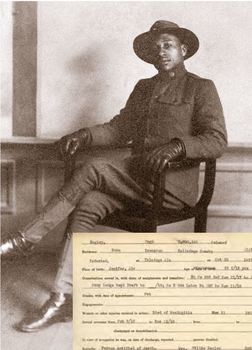 Uncle Sam wants you!—to help the Archives transcribe the records of Alabama soldiers like Hugh Bagley. (Alabama Department of Archives and History)
Uncle Sam wants you!—to help the Archives transcribe the records of Alabama soldiers like Hugh Bagley. (Alabama Department of Archives and History)
Adventures in Genealogy
Alabama History DIY: World War I Service Crowdsourcing Project
By Meredith McDonough
As part of the WWI centennial commemoration, the Alabama Department of Archives and History (ADAH) has undertaken a massive project—one that will surely offer numerous finds for genealogists with Alabama connections. The ADAH is digitizing the service records of over one hundred thousand individuals who served during WWI, and to accomplish this task before the centennial year concludes, it is seeking volunteers to assist in the project. Volunteers may work remotely, from the comfort of their own homes, and require no special training. To learn more or to join the effort, contact Meredith McDonough at [email protected].
About the Author
Meredith McDonough is the digital assets coordinator at the Alabama Department of Archives and History.
For Additional Information
For more information, please consult the following sites.
Alabama History DIY: World War I Service Crowdsourcing Project
By Meredith McDonough
As part of the WWI centennial commemoration, the Alabama Department of Archives and History (ADAH) has undertaken a massive project—one that will surely offer numerous finds for genealogists with Alabama connections. The ADAH is digitizing the service records of over one hundred thousand individuals who served during WWI, and to accomplish this task before the centennial year concludes, it is seeking volunteers to assist in the project. Volunteers may work remotely, from the comfort of their own homes, and require no special training. To learn more or to join the effort, contact Meredith McDonough at [email protected].
About the Author
Meredith McDonough is the digital assets coordinator at the Alabama Department of Archives and History.
For Additional Information
For more information, please consult the following sites.
 Henry Hughes tends Centennial Tree seedlings at the Birmingham Botanical Gardens. (L.J. Davenport)
Henry Hughes tends Centennial Tree seedlings at the Birmingham Botanical Gardens. (L.J. Davenport)
Nature Journal
Centennial Trees
By L.J. Davenport
As volatile weather sweeps across the state, it wreaks havoc on all kinds of inhabitants. We may often think of the damage to trees only in terms of their human cost—whether they hit any property. However, damage to local flora carries significant consequences, which some local botanists are trying to combat. Birmingham’s Henry Hughes leads the unique Centennial Tree Program, which aims to restore the native tree canopy throughout the city. Alabama Heritage’s resident naturalist, L. J. Davenport, describes the project and his own efforts to contribute seedlings to save Birmingham’s native trees.
About the Author
Larry Davenport is Paul N. Propst Professor of Natural Sciences at Samford University and co-author (with Ken Wills) of Exploring Wild Alabama (University of Alabama Press, 2016)
Centennial Trees
By L.J. Davenport
As volatile weather sweeps across the state, it wreaks havoc on all kinds of inhabitants. We may often think of the damage to trees only in terms of their human cost—whether they hit any property. However, damage to local flora carries significant consequences, which some local botanists are trying to combat. Birmingham’s Henry Hughes leads the unique Centennial Tree Program, which aims to restore the native tree canopy throughout the city. Alabama Heritage’s resident naturalist, L. J. Davenport, describes the project and his own efforts to contribute seedlings to save Birmingham’s native trees.
About the Author
Larry Davenport is Paul N. Propst Professor of Natural Sciences at Samford University and co-author (with Ken Wills) of Exploring Wild Alabama (University of Alabama Press, 2016)
Reading the Southern Past
Hurricanes in History
By Stephen Goldfarb
Just in time for hurricane season, this quarter’s installment of “Reading the Southern Past” looks at books about this weather phenomenon. Stephen Goldfarb considers Stuart B. Schwartz’s Sea of Storms: A History of Hurricanes in the Greater Caribbean from Columbus to Katrina (Princeton University Press, 2015) and Walter J. Fraser Jr.’s Lowcountry Hurricanes: Three Centuries of Storms at Sea (University of Georgia Press, 2006) to learn more about how hurricanes have affected the South for generations.
About the Author
Stephen Goldfarb holds a PhD in the history of science and technology. He retired from a public library in 2003.
For Additional Information
For more information, please see the following sites.
Hurricanes in History
By Stephen Goldfarb
Just in time for hurricane season, this quarter’s installment of “Reading the Southern Past” looks at books about this weather phenomenon. Stephen Goldfarb considers Stuart B. Schwartz’s Sea of Storms: A History of Hurricanes in the Greater Caribbean from Columbus to Katrina (Princeton University Press, 2015) and Walter J. Fraser Jr.’s Lowcountry Hurricanes: Three Centuries of Storms at Sea (University of Georgia Press, 2006) to learn more about how hurricanes have affected the South for generations.
About the Author
Stephen Goldfarb holds a PhD in the history of science and technology. He retired from a public library in 2003.
For Additional Information
For more information, please see the following sites.
